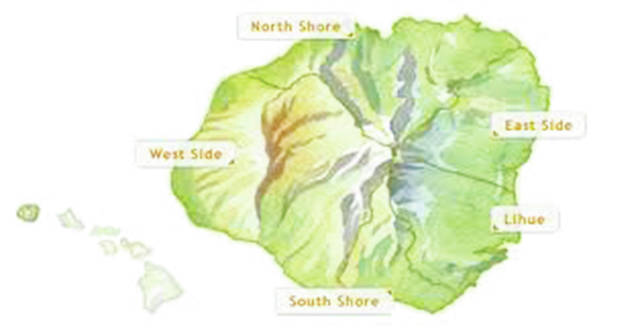Someone told me recently that they considered attending an event in the next town, but it seemed too far to drive on a cool, rainy night. We chuckled, and I realized that kind of thinking was not foreign to me, even though I know that our homeland is only about 35 miles wide from shore to shore in any direction from a bird’s eye view.
Strange, isn’t it, how after living on Kauai for awhile, distances that seemed short when you first arrived (if you are a malihini, newcomer) now seem long — and that’s not taking traffic slowdowns or jams into account. The realization of a new mind-set regarding expanding distances came to me about the third year after I moved my typewriter, books and teakettle to this place I have since called home. I’d learned that there were distinct geographical divisions beyond mauka and makai (mountains to sea), with differing demographics and distinct population types associated from North to South shores and East to West sides.
I was driving after work to my hula lesson in Kaumakani one afternoon, watching clouds and their shadows over Kahili Mountain, when it hit me that “my” island had enlarged to be my continent, if not my beloved world. What came of toying with that idea was a poem about it, “This Island.” It began,
The clouds before me
are earthborn continents,
escaped —
sky-framed Australia,
grand puff of Greenland,
peninsula and headlands,
blue Grecian isles, mapped
steppes
beyond the Hindu Kush.
During my life I had ricocheted around the world, India to Burma to Australia to America, so it was natural for Australia and the Hindu Kush to sneak into my new Kauai poem. But Greenland and Grecian isles were purely views I’d retained from poring over National Geographics. I’d lived in several states for protracted periods of time. I’d driven cross-
country twice and thought nothing of driving distances (even in snow) to catch a play or concert, or attend meetings.
Once settled on Kauai, in my free time I explored our beaches from Kee to Polihale, small lanes leading off the main roads, as well as the web of cane roads weaving through plantation lands. These explorations helped me after Hurricane Iniki, when I went to work as a member of a FEMA outreach team that walked areas off the beaten path to make sure people were connected with services. One of the members of our team was from a large Hawaiian family of Haena, and she was visibly surprised over my familiarity with the island, including her North Shore home area and the ancient hula site, Keahualaka.
Keahualaka is the place to which Kumu Roselle Bailey had connected all her Ka Imi hula and Hawaiian culture students and supporters. As an adult haumana hula (hula student) in her halau (school), I learned of her 1970s vision to bring this ancient place back from the jungle of vines and invasive plants and trees that had prevailed, making the archaeological site almost inaccessible.
Beyond vision, the project drew real dedication. It was no small drive from the Westside town of Kaumakani to the North Shore’s Kee, and Keahualaka for the Baileys (“Mr. B” was also very much involved) when they first gained permission to restore the site. I heard about how the chainsaws buzzed as the work began and progressed, and humorous stories about mistakes made — and lessons learned — as the first volunteers learned what plants were “native” and belonged there, and what were “introduced” and invasive.
I joined the groups who regularly carpooled to the North Shore to maintain and weed the site. At an uniki (graduation ceremony), I was proud to climb the rocky trail up the cliff and dance on the grassy platform high over Kee Lagoon. I’ve connected with this site many times since for various special ceremonies and private visits. The work of maintaining it continued; becoming “keepers” bonded all of us who were “volunteer” weeders and whackers for the Ka Imi school, which soon grew from being a halau into a full-fledged 501(c)3 educational Institute (www.kaimi.org), diverse in its cultural offerings, publications and programs.
Now, Ka Imi Institute has filmed, in cooperation with Serge Marcil/4D Media, the story of “Keahualaka, A Door to Hawaiian Spirituality,” including an in-depth interview of Roselle Bailey focusing on how her dream of restoration began, how it was implemented and followed through upon, and most importantly, how the site has been placed in Hawaiian hands for perpetuity. The film about this special Kauai place opens four evenings of the Garden Island Film Festival (GIFF) next week, two events taking place at The Shops at Kukuiula Village-Palm Court (March 21 and 24), and two at the Westin Princeville (March 22 and 23). The free outdoor 6:30 p.m. showings are to be announced by Film Kauai-GIFF with all details.
It may be no small drive for Kauai residents to make those “darkness falls” dates on the opposite shores of our island, but well worth it.
Beyond Ka Imi Institute’s story of “Keahualaka,” Film Commissioner Randall Francisco has a fine group of Kauai-related film offerings.
“We want to make this free festival an opportunity for local residents and visitors to attend in several locations,” Francisco told me.
If you happen to miss these March dates, then check for the May 25 showing at the small performance hall of Kauai Community College, in Puhi, where “Keahualaka” premiered in December.
•••
Dawn Fraser Kawahara, author and poet, made her home on Kauai in the 1980s. She and her husband, a retired biology teacher, live with books, music and birds in Wailua Homesteads. Shared passions are travel and nature. The writer’s books may be found in local outlets and on Amazon. For further information, tropicbirdpress@gmail.com.




